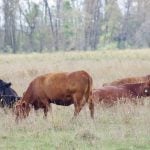Farmland prices in Manitoba and eastern Saskatchewan may have hit a wall, especially land at the high end of the market, says a real estate agent from Steinbach, Man.
“I’m seeing, in my day-to-day business, a market that is starting to flatten out in terms of price per acre. But still very strong in demand. It’s not a soft market. But it is flattening out in price,” said Stacey Hiebert, a Royal LePage agent for Riverbend Realty, who spoke at the Keystone Agricultural Producers annual general meeting held in early February in Winnipeg.
Read Also

Regulatory model “broken” in Canada – says BASF
Taking a decade to assess the safety of glufosinate-ammonium, a herbicide branded as Liberty that has been used by farmers for years, embodies what’s wrong with Canada’s regulatory system, BASF said.
Hiebert explained that most land sales happen in the late fall and winter, in the period between harvest and spring seeding.
This winter, producers remain keen about expanding their farms. However, they’re reluctant to pay extreme prices for the additional acres.
“The buyer is telling you: yes, I want to buy land,” Hiebert said. “But I’m not willing to pay you more than … the last price on record.”
Buyers are pushing back, in particular, on prices for the most expensive land.
“Land at $3,000 an acre, $4,000 an acre, probably has a bigger upswing in the market than the land already at $5,000 or $6,000 (per acre),” Hiebert said. “The land at six ($6,000) is starting to top out. I believe.”
That’s a different trend from 2017, when buyers were willing to pay more for high-valued land, thus driving prices higher.
Hiebert emphasized that his observations are based on trends in the market and not fundamentals.
A flatter market for the most expensive farmland isn’t surprising because grain and oilseed prices are relatively weak and farm income is down. Net farm income plummeted 46 percent (in constant 2012 dollars) in 2018 after seven years of above-average incomes, Statistics Canada reported last year.
Land prices may be going sideways this winter, but several farmers at the Keystone Agricultural Producers meeting said they’re concerned about the sustainability of high land prices.
“If we get to a point where it (farmland) won’t turn a profit because of fixed costs … then what happens to land values?” said Mitch Janssens, who farms near Boissevain.
It’s unlikely that Canadian farmers will see a repeat of the 1980s, when land prices dropped off a cliff, because interest rates are low, Canada has trade deals with numerous countries and there are new players in the land market, like institutional investors.
“The pool of farmland owners is getting more diverse and bigger … bringing (in) non-traditional buyers of farmland,” said J.P. Gervais, FCC vice-president and chief agricultural economist.
Another change in the farmland market is that regions are getting smaller. Not long ago, a realtor could rely upon sales data in a particular municipality and use that to estimate price.
Those days may be over.
“We used to look at a very large region when we looked at sales histories. That (region) is getting tighter and tighter,” Hiebert said. “It’s starting now to depend on who is your neighbour. And who is your neighbour’s neighbour.”
If there are a few large farmers in the region competing for available land, that could drive up local prices.
If there is a potato grower within a few kilometres, he might be willing to pay above asking price to get another quarter section for potato production, for example.
The local influence on price makes life more confusing for real estate agents, farmland buyers and sellers. Everybody needs to gather more information before deciding on price, Hiebert said.
“We get the questions of why would the neighbour pay so much for that quarter section? Typically, (that price) comes from the coffee shop, which is typically not correct,” he said.
“If you want to know, do your research. Don’t go to the coffee shop.”















